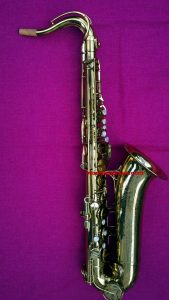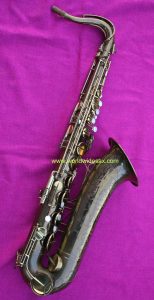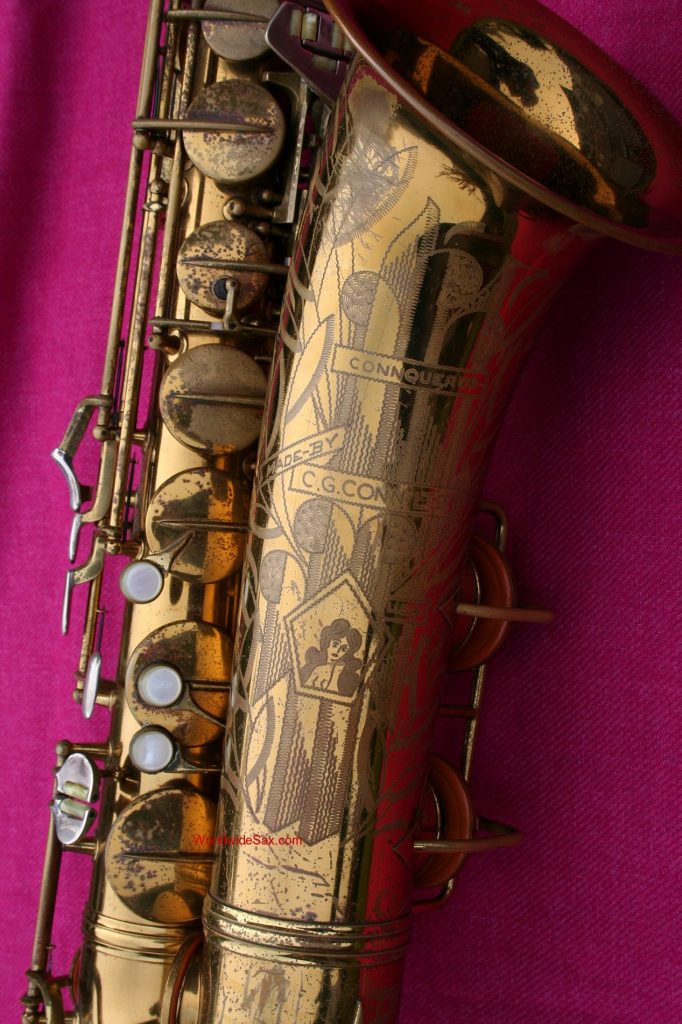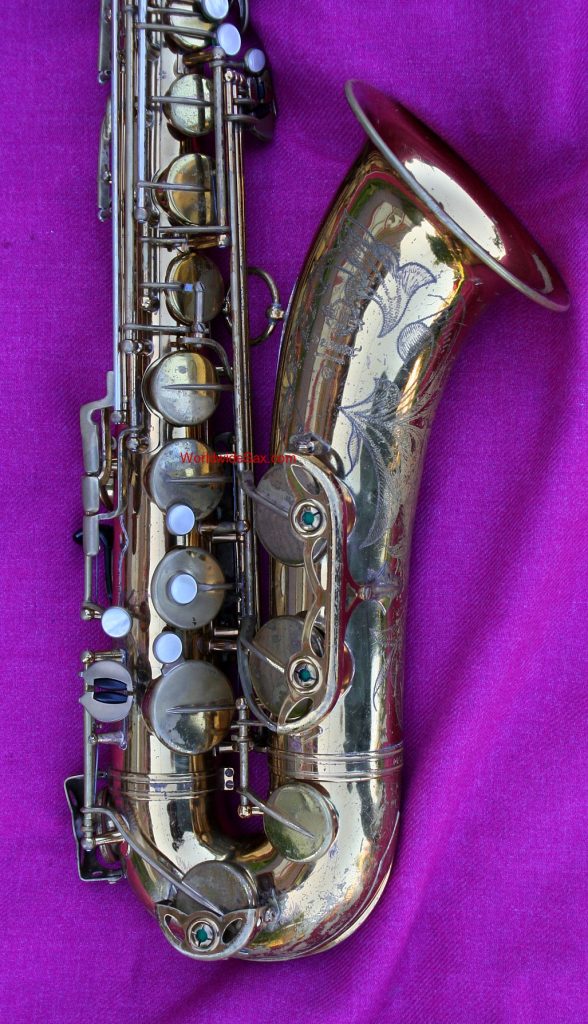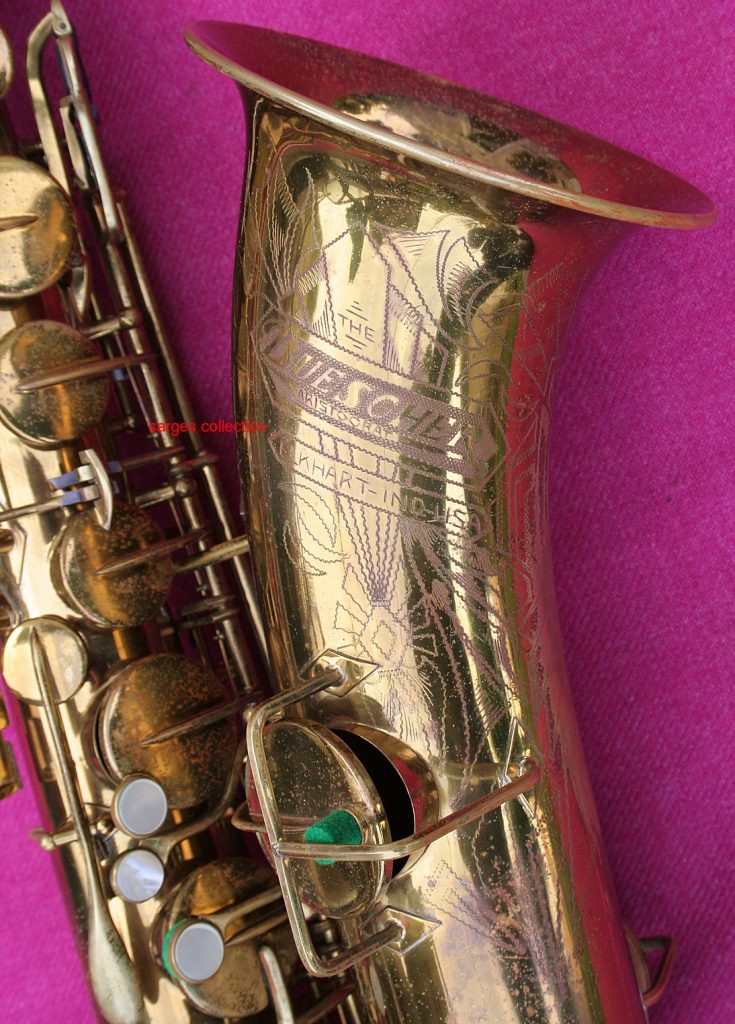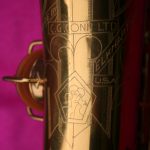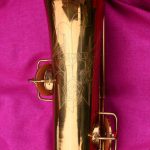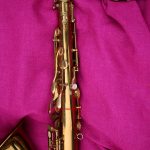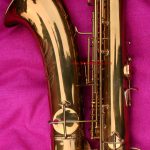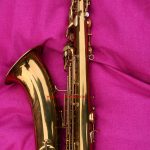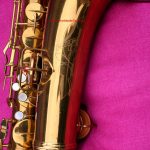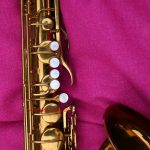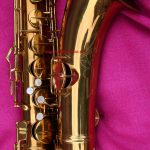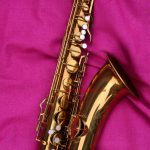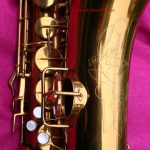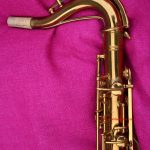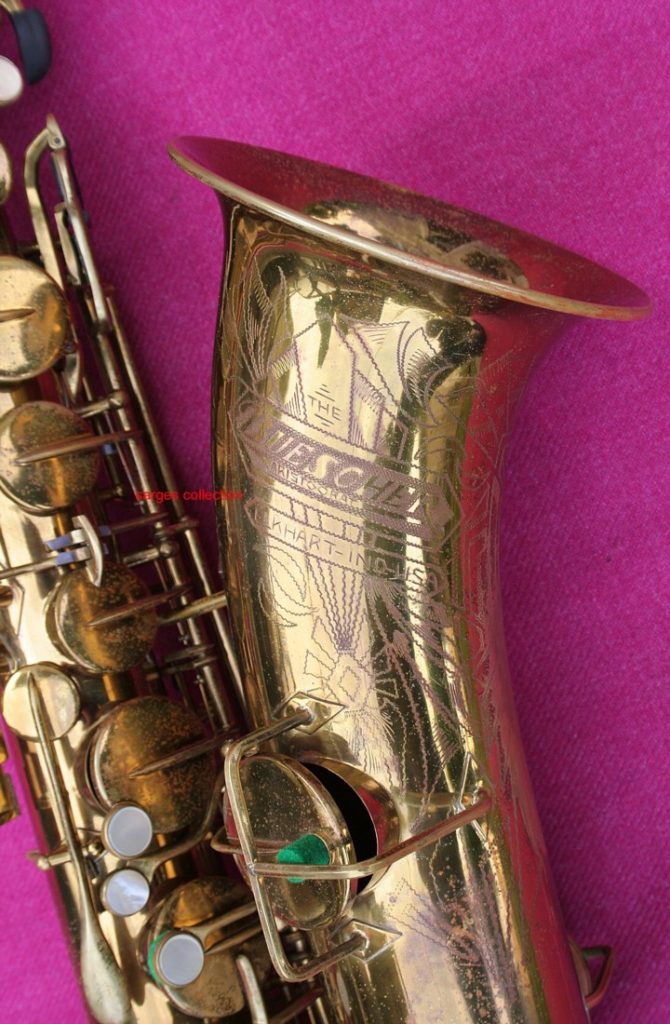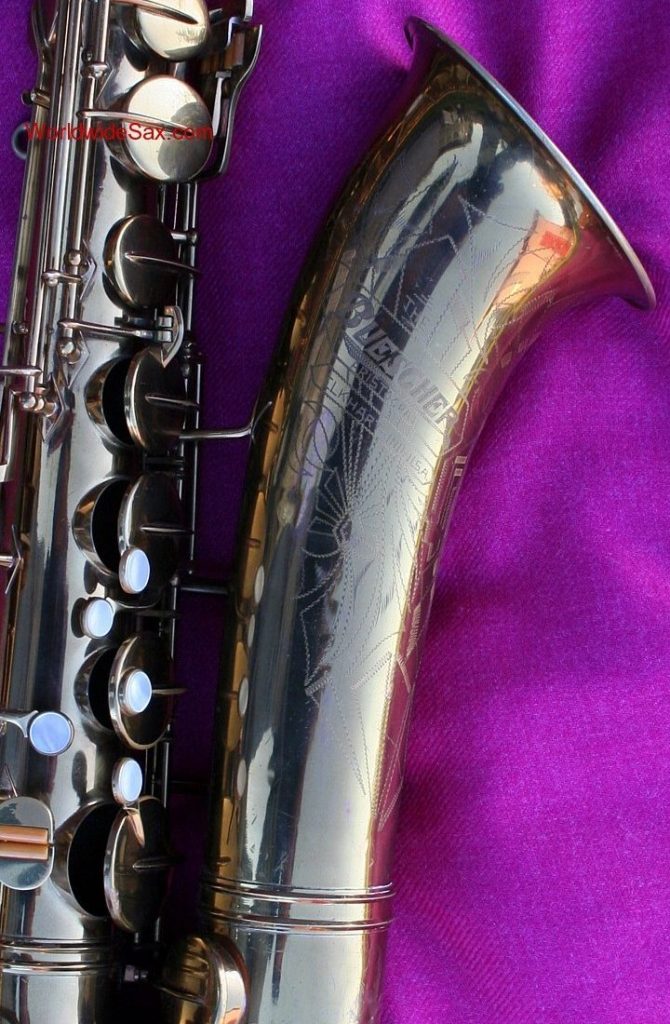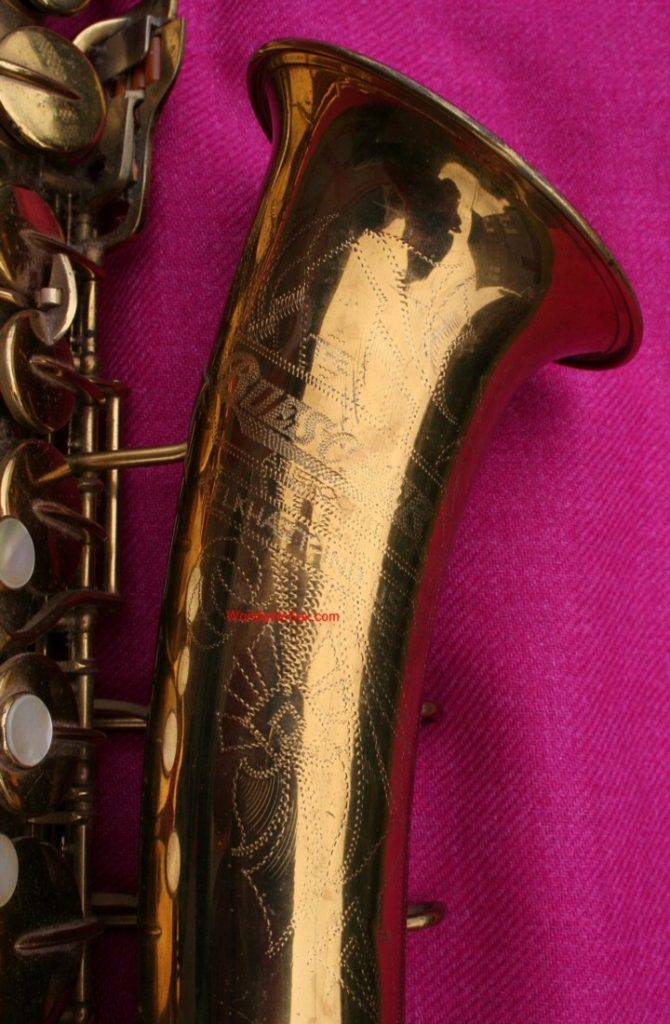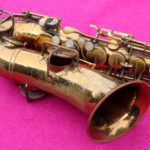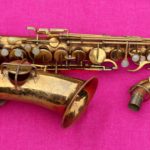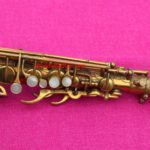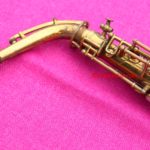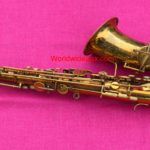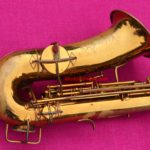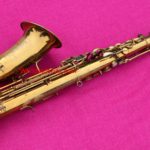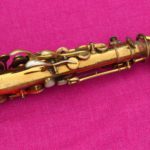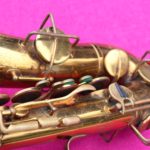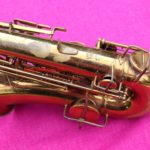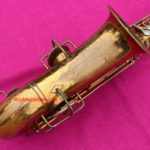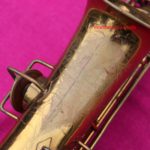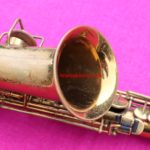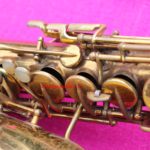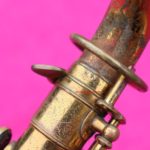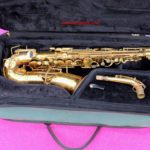About Relacquers
Our Expert Opinions, Plus Research Education
Sarge: "I wanted to weigh in my opinion on Relacquers and Restorations, because I get almost daily emails, wanting to know what I think about them."
A vintage horn is heavier and more solid than today's Chinese, Taiwanese or Japanese horns... and can usually take one relac/buffing, without any real ill effects... but many "+50 year old" horns have been relacquered 2, even 3 times. By the time this happens, weight is lost from the horn and the sound does change. Take a look at a sax that has been buffed and relacquered so many times, the engraving is virtually gone. This is not a wise choice, for a potential buyer.
Now, restorations, like my silver plating jobs, work great, if a horn has only been
relacquered once... the weight is added back on, with the new coat of silver and the engravings are restored (by re-Engraving) to bring back the beauty of the horn. My opinion is the best thing you can do for a overbuffed, dented up horn is to play it until you can get yourself something better. You will know "better" when you see it, after you have worked your way through a few ebay disasters...
More Relacquer Info
I have received so many questions and requests about Vintage instrument finishes and lacquers, that I have created this page to try to help answer your questions. There are many tricks to uncovering the history of a sax, it's history of repairs and care. There are also as many tricks to cover it up as well. A really good refinish will look just like the original finish.
Below is a common relacquered finish on a Conn 10M Naked Lady. Can you find the Lady?

Sometimes when you see an ad, it will say Factory Relacquer...the reason this is desirable, is the factory will usually have the exact color tint formula, for an authentic look. An elderly Selmer should have a dark gold hue to it. As it ages, it will take on a sort of brownish-red highlight near the edges of some areas. This is usually because the original technician, many years ago, polished and cleaned all the acid and residue, off the main bell, but missed some at the outside edges. This continues to oxidize under the lacquer and cause color variations. A 40's instrument without any blemishes or discoloration could be a relacquer. A older instrument with a light gold finish like a Yamaha is probably not original.
Runs in the lacquer are a dead give-away. Look for paint that has sags or runs off of posts... then it almost surely is a relaq. Another good way to tell, is if the lacquer fills in and smoothes out the engraved areas of the bell and serial number location. Original engravers received the horn after it had been lacquered, and then cut the engraving, by hand, through the lacquer, into the bell or other areas. This was frequently done with a temporary tattoo, called a STENCIL, (a drawing of the pattern they are going to engrave on the sax was called a stencil) hence the term "Conn stencil" etc. The engraver would transfer the stencil pattern onto the bell and then follow it's pattern as he engraved.
Yet another give-away is to look for fine scratches under the lacquer. When the finish is removed, the buffing process can leave tiny lines in the metal. These are then lacquered over and can be seen where it was hard to do the fine buffing and rouge polishing process, like behind the bell, around the keyholes, etc. Many times red rouge compound can be found inside the toneholes too. That said, many fine horns, such as mid 60's Selmer have buffing lines under original lacquer... sometimes rouge in the horn too. This is normal and sometimes happened because they hurried their work too much, trying to keep up with production.
The most difficult "tell" is the depth of the engraving. It should be clear and deep and a little rough to the touch. If the instrument has had the original lacquer buffed off, it takes a couple thousandths of an inch of metal off the engraved area and lightens the engraving.
It is most difficult to tell the engraving depth on French instruments from the 40's and 50's. The French seem to engrave very lightly, and this makes the depth tell difficult. When in doubt, take it to the very best vintage sax specialist in your area for a 2nd opinion.
I also frequently see acid bleed and copper bleed under the finish on Selmers. This was probably due to an overall rushing the manufacturing, assembly and finishing, in order to keep up with the overwhelming demand for Super Balanced Action and Mark VI saxes. A little solder acid under the finish, not thoroughly cleaned off, will show up years later as discoloration. There are several things that will cause discoloration, but they are considered part of the "original" finish and therefore do not detract from the value or playability of the instrument.
Note the smoothness of the engraving. It should be sharp and distinct and maybe even have a little corrosion in the lines that are cut through the lacquer into the brass. The engraved lines here are filled in with lacquer and smooth, rather than cut and sharp.
Thanks, Sarge
"When in doubt, it is probably a Relacquer."
Here I (Chadd) put together a side by side comparison of two "The Martin Tenor"s for your viewing.
On the Left, 1945 a one-time relac, good playing, deep tone due to the early serial number era(153K). On the Right, a 1948 Original lacquer(164k). Notice the clearer cut engraving and deep, deep patina on this one. Still deep tones for the serial range and darker lacquer than the later 50s/60s era Martins. However, in person, i must attest that the relac engraving was much more noticeable, to give it some credit. ...oh! and the #164K original tenor has keys that were relacquered! Tricky!Enjoy, chadd.
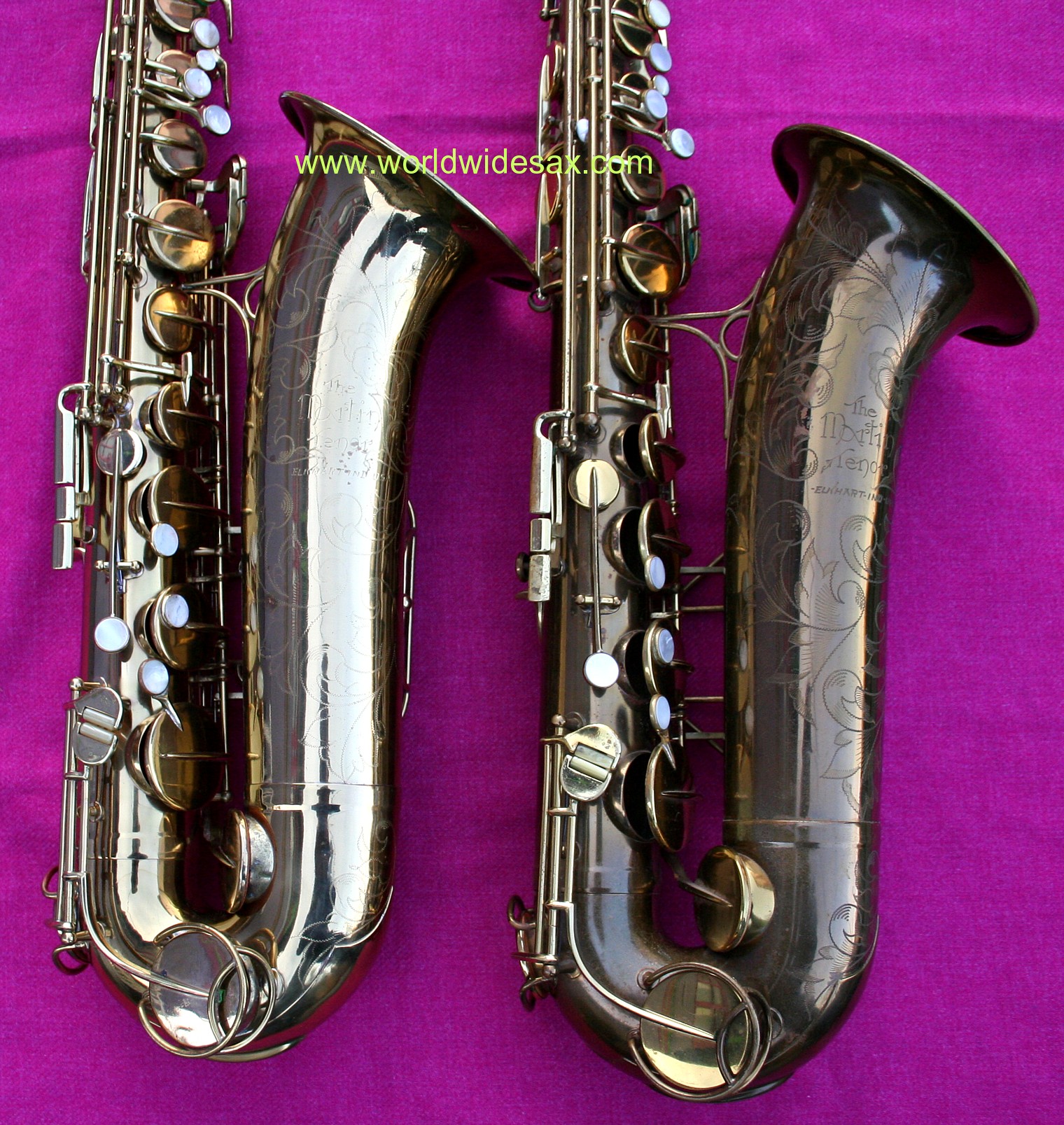
Relac solo photo (LEFT)
Original solo photo (RIGHT)
When did lacquer start being used?
Rumor has is that Conn did some experiments in the 1920s; but you can't find any "originals", as we would call them, until the early 1930s. That is,
"originals" by our modern inspections. In my opinion, it only makes sense that the manufacturing process experimented with when and how to lacquer, and with regard to which step in the manufacturing process. Was is "before engraving or after"? Was is a multi-step process? Example/Idea: Lacquer, prep, lacquer, engrave, lacquer, polish,
lacquer....etc.
Most big companies adapted to engrave as a final step for a while. That helps get that "cut" look we all love that allows the brass to tarnish in
time for a color contrast. This is commonly seen in the vintage sax world.
Here's some of that Cut Look:
1936 Conn 30M:
1968 Selmer Mark VI:
1934 Buescher Aristocrat tranny:
We know that Selmer Mark VI's changed the order to lacquering steps with engraving too!...in the 1970s! ...still experimenting? Ha, Always! Their floral patterns (and most French brands) are the most faint when compared to the American horns' and engraving style.
I find that the best two timeline examples are with this trait are:
- Buescher Aristocrat series 1, "The Aristocrat"
- Conn M series, "Naked Lady"s ....from the era, you catch this on the "transitional" models between the Chu and the Naked Lady
1934 Conn Transitional Tenor
New Wonder II/"Chu Berry" Transitional 10M (with "naked lady")
Please ignore the few raindrops that made it on camera. Serial #260,xxx. If ever a sax should get relacquered, it should look like this one! Although up for discussion, this could be a Professional job that could have happened in the late 1940s or 50s. It's a true beauty and I can't tell how many people ask us about a Pretty "chu" in lacquer. Could it be original?! I THINK IT IS ORIGINAL LACQUER!
Timeline dates it to the beginning of lacquered saxes...Hmmm }}} ...one reason to help support this is because i was able to get the story of the this sax from the original owners' son. So the true "cool factor" is that this tranny era Conn has the Chu keywork and the Naked Lady engravings -- all still highly visible from the pro lacquer work. It also features the distinct Rolled Tone Holes of the era and the big, early Chu sound. The sax is in overall good shape aside from the relacquer, neck looks good -- minor dings to mention (see photos) and perhaps the only major damage in its lifetime happened to the high E area where the damage only shows the repair.
SOLD Sound File: Selmer VI vs Conn Chu tranny vs Buescher 400 TopHat&Cane
- 1.TENOR- VI_ChuTranny_B400THC2:24
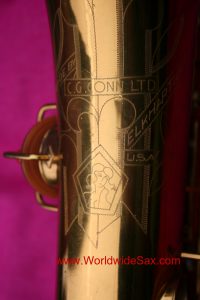
Bueschers in the 1930s...
I have seen several common dark lacquer Bueschers from the 30s that don't match the prior and later lacquer
prep style. There was less 'cut' after the finish. Again, more debates but after seeing so many similar series 1's...
Here, enjoy some beautiful pictures. 🙂
- (LEFT) 1934 Buescher Aristocrat transitional model. A beautiful original from Sarge's collection.
- (MIDDLE) 1937 Buescher Aristocrat. I believe this is what the originals changed to as the process evolved.
- (RIGHT) 1938 Buescher Aristocrat. I believe this alto is a good relacquer. Tricky! no?
1930 Buescher "True Tone", Series IV Alto

For myself, I have to note that I looked very hard at this sax. I did not see any guarantees in one way or another for a relacquer label. But I will note that among the gunk I did see some red that looks like buffing rouge in the Eb guard top foot, and near the Eb trill key guard. Even still, the factory would have buffed a sax too. So is this factory work or after build work? There was some over buffing on the "true tone" stamping on the rear body tube, but not the serial number. The bell engraving looks like the lacquer was after the cutting - even so! this early era was a time when the companies had to experiment when they would lacquer (before or after engraving stages).
Original lacquer: I vote YES!! I looked very close at this because I had not dated original lacquer use on a Buescher prior to 1934 (yet); of course there were rumors of Conn experimenting with lacquer in the 20s, but not formally on production. According to resources like Saxpics.com, the next model (New Aristocrat) was available in lacquer finish. If this is not "original", it must be the "first time lacquer"/Factory job and excellently done because I did not see any proof of poor quality work on it. I also like the deep color of the lacquer for research and personal preference.
Additional Note: These did have steel needle springs on this version (not gold Nortons), the added bis rocker arm on the F# key bridge, and removal of the pants-guard-bar along the B1 area(vs series III).
That is all for now!

